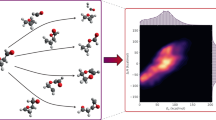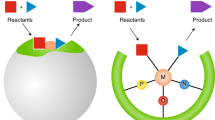Abstract
Solvents can significantly alter the rates and selectivity of liquid-phase organic reactions, often hindering the development of new synthetic routes or, if chosen wisely, facilitating routes by improving rates and selectivities. To address this challenge, a systematic methodology is proposed that quickly identifies improved reaction solvents by combining quantum mechanical computations of the reaction rate constant in a few solvents with a computer-aided molecular design (CAMD) procedure. The approach allows the identification of a high-performance solvent within a very large set of possible molecules. The validity of our CAMD approach is demonstrated through application to a classical nucleophilic substitution reaction for the study of solvent effects, the Menschutkin reaction. The results were validated successfully by in situ kinetic experiments. A space of 1,341 solvents was explored in silico, but required quantum-mechanical calculations of the rate constant in only nine solvents, and uncovered a solvent that increases the rate constant by 40%.
This is a preview of subscription content, access via your institution
Access options
Subscribe to this journal
Receive 12 print issues and online access
$259.00 per year
only $21.58 per issue
Buy this article
- Purchase on Springer Link
- Instant access to full article PDF
Prices may be subject to local taxes which are calculated during checkout



Similar content being viewed by others
References
Reichardt, C. & Welton, T. Solvents and Solvent Effects in Organic Chemistry (Wiley-VCH, 2011).
Maki, B. E., Patterson, E. V., Cramer, C. J. & Scheidt, K. A. Impact of solvent polarity on N-heterocyclic carbene-catalyzed β-protonations of homoenolate equivalents. Org. Lett. 11, 3942–3945 (2009).
Carlson, R. Designs for explorative experiments in organic synthetic chemistry. Chemom. Intell. Lab. Syst. 73, 151–166 (2004).
Gani, R., Jiménez-González, C. & Constable, D. J. C. Method for selection of solvents for promotion of organic reactions. Comput. Chem. Eng. 29, 1661–1676 (2005).
Otto, R. et al. Single solvent molecules can affect the dynamics of substitution reactions. Nature Chem. 4, 534–538 (2012).
Jiménez-González, C. et al. Key green engineering research areas for sustainable manufacturing: a perspective from pharmaceutical and fine chemicals manufacturers. Org. Process Res. Dev. 15, 900–911 (2011).
Achenie, L. E. K., Gani, R. & Venkatasubramanian, V. (eds) Computer Aided Molecular Design: Theory and Practice (Elsevier, 2003).
Giovanoglou, A., Barlatier, J., Adjiman, C. S., Pistikopoulos, E. N. & Cordiner, J. L. Optimal solvent design for batch separation based on economic performance. AIChE J. 49, 3095–3109 (2003).
Fredenslund, A., Jones, R. L. & Prausnitz, J. M. Group-contribution estimation of activity-coefficients in nonideal liquid mixtures. AIChE J. 21, 1086–1099 (1975).
Folić, M., Adjiman, C. S. & Pistikopoulos, E. N. Design of solvents for optimal reaction rate constants. AIChE J. 53, 1240–1256 (2007).
Folić, M., Adjiman, C. S. & Pistikopoulos, E. N. Computer-aided solvent design for reactions: Maximizing product formation. Ind. Eng. Chem. Res. 47, 5190–5202 (2008).
Carlson, R. & Carlson, J. E. Design and Optimization in Organic Synthesis (Elsevier, 2005).
Koppel, I. A. & Palm, V. A. in Advances in Linear Free Energy Relationships (eds Chapman, N. B. & Shorter, J.) Ch. 5 (Plenum Press, 1972).
Kamlet, M. J., Abboud, J. L. & Taft, R. W. The solvatochromic comparison method. 6. The π* scale of solvent polarities. J. Am. Chem. Soc. 99, 6027–6038 (1977).
Taft, R. W., Pienta, N. J., Kamlet, M. J. & Arnett, E. M. Linear solvation energy relationships. 7. Correlations between the solvent-donicity and acceptor-number scales and the solvatochromic parameters, π*, α, and β. J. Org. Chem. 46, 661–667 (1981).
Taft, R. W., Abboud, J. L. M. & Kamlet, M. J. Linear solvation energy relationships. 12. The dδ term in the solvatochromic equations. J. Am. Chem. Soc. 103, 1080–1086 (1981).
Kamlet, M. J., Abboud, J-L. M., Abraham, M. H. & Taft, R. W. Linear solvation energy relationships. 23. A comprehensive collection of the solvatochromic parameters, π*, α and β, and some methods for simplifying the generalized solvatochromic equation. J. Org. Chem. 48, 2877–2887 (1983).
Taft, R. W., Abboud, J-L. M., Kamlet, M. J. & Abraham, M. H. Linear solvation energy relations. J. Solution Chem. 14, 153–186 (1985).
Bini, R., Chiappe, C., Mestre, V. L., Pomelli, C. S. & Welton, T. A rationalization of the solvent effect on the Diels–Alder reaction in ionic liquids using multiparameter linear solvation energy relationships. Org. Biomol. Chem. 6, 2522–2529 (2008).
Gani, R., Gómez, P. A., Folić, M., Jiménez-González, C. & Constable, D. J. C. Solvents in organic synthesis: replacement and multi-step reaction systems. Comput. Chem. Eng. 32, 2420–2444 (2008).
Stanescu, I. & Achenie, L. E. K. A theoretical study of solvent effects on Kolbe–Schmitt reaction kinetics. Chem. Eng. Sci. 61, 6199–6212 (2006).
Menschutkin, N. A. Über die Affinitätskoeffizienten der Alkylhaloide und der Amine. Z. Physik. Chem. 6, 41–57 (1890).
Abraham, M. H. & Grellier, P. L. Substitution at saturated carbon. Part XX. The effect of 39 solvents on the free energy of Et3N, EtI, and the Et3N–EtI transition state. Comparison with solvent effects on the equilibria Et3N + EtI ↔ Et4N+I− and Et3N + EtI ↔ Et4N++ I−. J. Chem. Soc. Perkin Trans. 2 1735–1741 (1976).
Lassau, C. & Jungers, J. L'influence du solvant sur la réaction chimique. La quaternation des amines tertiaires par l'iodure de méthyle. Bull. Soc. Chim. Fr. 7, 2678–2685 (1968).
Castejon, H. & Wiberg, K. B. Solvent effects on methyl transfer reactions. 1. The Menshutkin reaction. J. Am. Chem. Soc. 121, 2139–2146 (1999).
Acevedo, O. & Jorgensen, W. L. Exploring solvent effects upon the Menshutkin reaction using a polarizable force field. J. Phys. Chem. B 114, 8425–8430 (2010).
Chuang, Y-Y., Cramer, C. J. & Truhlar, D. G. The interface of electronic structure and dynamics for reactions in solution. Int. J. Quantum Chem. 70, 887–896 (1998).
Su, P., Wu, W., Kelly, C. P., Cramer, C. J. & Truhlar, D. G. VBSM: a solvation model based on valence bond theory. J. Phys. Chem. A 112, 12761–12768 (2008).
Pearson, R. G., Langer, S. H., Williams, F. V. & McGuire, W. J. Mechanism of the reaction of α-haloketones with weakly basic nucleophilic reagents. J. Am. Chem. Soc. 74, 5130–5132 (1952).
Barnard, P. W. C. & Smith, B. V. The Menschutkin reaction – a group experiment in a kinetic study. J. Chem. Educ. 58, 282–285 (1981).
Forster, W. & Laird, R. M. The mechanism of alkylation reactions. 1. The effect of substituents on the reaction of phenacyl bromide with pyridine in methanol. J. Chem. Soc. Perkin Trans. 2 135–138 (1982).
Hwang, J. U., Chung, J. J., Yoh, S. D. & Jee, J. G. Kinetics for the reaction of phenacyl bromide with pyridine in acetone under high pressure. Bull. Korean Chem. Soc. 4, 237–240 (1983).
Halvorsen, A. & Songstad, J. The reactivity of 2-bromo-1-phenylethanone (phenacyl bromide) toward nucleophilic species. J. Chem. Soc. Chem. Commun. 327–328 (1978).
Eyring, H. The activated complex in chemical reactions. J. Chem. Phys. 3, 107–115 (1935).
Evans, M. G. & Polanyi, M. Some applications of the transition state method to the calculation of reaction velocities, especially in solution. Trans. Faraday Soc. 31, 875–894 (1935).
Jalan, A., Ashcraft, R. W., West, R. H. & Green, W. H. Predicting solvation energies for kinetic modeling. Annu. Rep. Prog. Chem. C 106, 211–258 (2010).
Marenich, A. V., Cramer, C. J. & Truhlar, D. G. Universal solvation model based on solute electron density and on a continuum model of the solvent defined by the bulk dielectric constant and atomic surface tensions. J. Phys. Chem. B 113, 6378–6396 (2009).
Poling, B. E., Prausnitz, J. M. & O'Connell, J. P. The Properties of Gases and Liquids (McGraw-Hill, 2000).
Marrero, J. & Gani, R. Group-contribution based estimation of pure component properties. Fluid Phase Equilibr. 183–184, 183–208 (2001).
Winget, P., Dolney, D. M., Giesen, D. J., Cramer, C. J. & Truhlar, D. G. Minnesota Solvent Descriptor Database, http://comp.chem.umn.edu/solvation/mnsddb.pdf (2010).
Sheldon, T. J., Adjiman, C. S. & Cordiner, J. L. Pure component properties from group contribution: hydrogen-bond basicity, hydrogen-bond acidity, Hildebrand solubility parameter, macroscopic surface tension, dipole moment, refractive index and dielectric constant. Fluid Phase Equilibr. 231, 27–37 (2005).
Sheldon, T. J., Folić, M. & Adjiman, C. S. Solvent design using a quantum mechanical continuum solvation model. Ind. Eng. Chem. Res. 45, 1128–1140 (2006).
Abraham, M. H., Doherty, R. M., Kamlet, M. J., Harris, J. M. & Taft, R. W. Linear solvation energy relationships. Part 37. An analysis of contributions of dipolarity–polarisability, nucleophilic assistance, electrophilic assistance, and cavity terms to solvent effects on t-butyl halide solvolysis rates. J. Chem. Soc. Perkin Trans. 2, 913–920 (1987).
Abraham, M. H., Doherty, R. M., Kamlet, M. J., Harris, J. M. & Taft, R. W. Linear solvation energy relationships. Part 38. An analysis of the use of solvent parameters in the correlation of rate constants, with special reference to the solvolysis of t-butyl chloride. J. Chem. Soc. Perkin Trans. 2, 1097–1101 (1987).
Kamlet, M. J., Abraham, M. H., Doherty, R. M. & Taft, R. W. Solubility properties in polymers and biological media. 4. Correlation of octanol/water partition coefficients with solvatochromic parameters. J. Am. Chem. Soc. 106, 464–466 (1984).
Abraham, M. H. Scales of solute hydrogen bonding: their construction and application to physicochemical and biochemical processes. Chem. Soc. Rev. 22, 73–83 (1993).
Abraham, M. H. Application of solvation equations to chemical and biochemical processes. Pure Appl. Chem. 65, 2503–2512 (1993).
Gao, C., Govind, R. & Tabak, H. H. Application of the group contribution method for predicting the toxicity of organic chemicals. Environ. Toxicol. Chem. 11, 631–636 (1992).
Stefanis, E., Constantinou, L. & Panayiotou, C. A group-contribution method for predicting pure component properties of biochemical and safety interest. Ind. Eng. Chem. Res. 43, 6253–6261 (2004).
Frisch, M. J. et al. Gaussian09 Revision A.1 (Gaussian Inc., Wallingford, Connecticut, 2009).
Acknowledgements
The authors acknowledge funding from the Engineering and Physical Sciences Research Council (EPSRC) (EP/E016340, EP/J003840/1, EP/J014958/1), funding from EPSRC and Syngenta Cooperative Awards in Science and Engineering (CASE) award, access to computational resources and support from the High Performance Computing Cluster at Imperial College London. We are thankful to D. Blackmond for valuable discussions.
Author information
Authors and Affiliations
Contributions
H.S. contributed to the QM-CAMD methodological development and carried out all computations, with the help of P.G.K. and E.S. Z.G. performed and analysed all the experiments, with the help of P.H. for the NMR measurements. P.M.P. provided input for the interpretation of the kinetic data. A.A., A.G. and C.S.A. designed the methodology, supervised the project and prepared the manuscript. All authors edited the manuscript.
Corresponding author
Ethics declarations
Competing interests
The authors declare no competing financial interests.
Supplementary information
Supplementary information
Supplementary information (PDF 1406 kb)
Rights and permissions
About this article
Cite this article
Struebing, H., Ganase, Z., Karamertzanis, P. et al. Computer-aided molecular design of solvents for accelerated reaction kinetics. Nature Chem 5, 952–957 (2013). https://doi.org/10.1038/nchem.1755
Received:
Accepted:
Published:
Issue Date:
DOI: https://doi.org/10.1038/nchem.1755
This article is cited by
-
Effect of radiolysis and radiolytic products of tri-iso-amyl phosphate on the extraction behavior of uranium
Journal of Radioanalytical and Nuclear Chemistry (2023)
-
Effect of radiolysis of TODGA on the extraction of TODGA/n-dodecane toward Eu(III): an experimental and DFT study
Nuclear Science and Techniques (2023)
-
SN2 versus E2 reactions in a complex microsolvated environment: theoretical analysis of the equilibrium and activation steps of a nucleophilic fluorination
Journal of Molecular Modeling (2022)
-
A carbon neutral chemical industry powered by the sun
Discover Chemical Engineering (2021)
-
Computational design of heterogeneous catalysts and gas separation materials for advanced chemical processing
Frontiers of Chemical Science and Engineering (2021)



